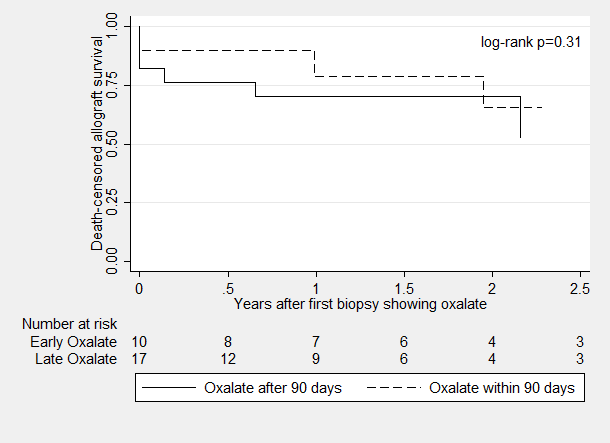Calcium Oxalate Deposition in Kidney Allografts: Clinical Chracteristics and Outcome
S. Sritharan1, J. Kamal2, S. A. Husain1, I. Batal1, J. Chang1
1Columbia University Irving Medical Center, New York, NY, 2University of Virginia, Charlottesville, VA
Meeting: 2020 American Transplant Congress
Abstract number: C-035
Keywords: Biopsy, Graft failure, Kidney transplantation, Metabolic complications
Session Information
Session Name: Poster Session C: Kidney: Cardiovascular and Metabolic Complications
Session Type: Poster Session
Date: Saturday, May 30, 2020
Session Time: 3:15pm-4:00pm
 Presentation Time: 3:30pm-4:00pm
Presentation Time: 3:30pm-4:00pm
Location: Virtual
*Purpose: To better understand its clinical significance and prognostic value, we investigated the clinical characteristics and outcomes of patients with calcium oxalate deposition in kidney allograft biopsies.
*Methods: We performed a retrospective study of 27 consecutive kidney transplant patients with at least one for-cause allograft biopsy that showed calcium oxalate deposition between 2007 and 2019 in our transplant center, including ten patients with biopsies performed within 90 days post-transplantation (group 1) and 17 after 90 days post-transplantation (group 2).
*Results: The two groups were comparable with respect to need for dialysis before transplant (90 vs. 94%), presence of known risk factors for enteric oxalate nephropathy including chronic bowel disease (20 vs. 24%), prior gastrointestinal surgery (30 vs. 29%), diarrhea (40 vs. 53%) and antibiotic use (40 vs. 41%), and median serum creatinine level at the time of biopsy [3.43 (2.26-6.38) vs. 3.01 (2.17-5.35) mg/dl] (see table). The median post-transplant time to first biopsy with calcium oxalate deposition was 62 days (40-73 days) in group 1 and 1555 days (383-2635 days) in group 2. Almost all (26/27) biopsies showed presence of concurrent acute tubular injury of various degrees of severity. There was a higher occurrence of concomitant rejection (acute or chronic active T-cell mediated and/or acute or chronic active antibody-mediated) (0 vs. 41%) in biopsies obtained after 90 days post-transplantation. Graft outcome after the diagnosis of calcium oxalate deposits was similar between the two groups (p=0.31, see figure).
*Conclusions: Calcium oxalate deposition in kidney allograft biopsies is rare but can be observed in both early and late period after transplantation. While it remains unclear whether calcium oxalate deposition is contributing or resulting from poor allograft function, it appears to occur more frequently with concomitant rejection in late post-transplant course. Therefore, our data suggest that in the presence of calcium oxalate deposition in late post-transplant period, additional causes of allograft dysfunction including rejection should be sought.
| All (n=27) | Within 90 days (n=10) | After 90 days (n=17) | |
| Pre-transplant dialysis | 25 (93%) | 9 (90%) | 16 (94%) |
| Chronic bowel disease | 6 (22%) | 2 (20%) | 4 (24%) |
| Prior gastrointestinal surgery | 8 (30%) | 3 (30%) | 5 (29%) |
| Serum creatinine at first biopsy with oxalate (mg/dL), median (IQR) | 3.00 (2.20-6.10) | 3.43 (2.26-6.38) | 3.01 (2.17-5.35) |
| Diarrhea | 13 (48%) | 4 (40%) | 9 (53%) |
| Antibiotic use | 11 (41%) | 4 (40%) | 7 (41%) |
| Concomitant rejection | 7 (26%) | 0 (0%) | 7 (41%) |
To cite this abstract in AMA style:
Sritharan S, Kamal J, Husain SA, Batal I, Chang J. Calcium Oxalate Deposition in Kidney Allografts: Clinical Chracteristics and Outcome [abstract]. Am J Transplant. 2020; 20 (suppl 3). https://atcmeetingabstracts.com/abstract/calcium-oxalate-deposition-in-kidney-allografts-clinical-chracteristics-and-outcome/. Accessed January 4, 2026.« Back to 2020 American Transplant Congress

